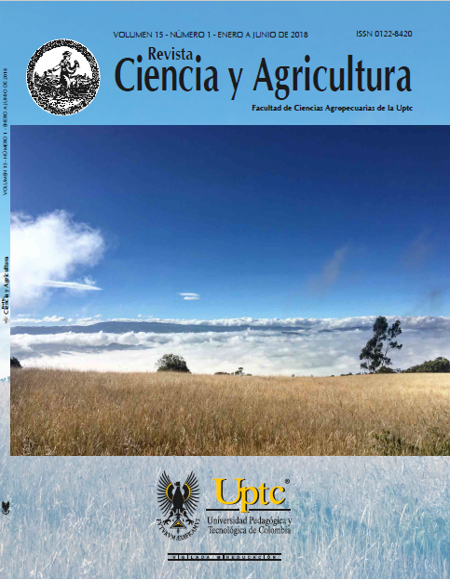Diazotrophic bacteria with activity promoting vegetable growth in Daucus carota L.
DOI:
https://doi.org/10.19053/01228420.v15.n1.2018.7753Keywords:
carrot, nitrogen fixation, nitrogenase activity, phosphate solubilizationAbstract
This study aimed at isolating diazotrophic bacteria with promoting activity of vegetal growth, associated to carrot culture. Samples were taken at 30, 60 and 115 days in a farm located in a rural area of the municipality of Manizales (Caldas). The diazotrophic bacteria were isolated in semi-solid culture media free of nitrogen. We described the macro and microscopic features of the obtained isolations, and identified them biochemically and molecularly. In addition, we evaluated indole compounds, nitrogenase activity and solubilization of phosphates. Gluconacetobacter diazotrophicus ATCC 49037 was used as a standard strain. We recovered 20 isolates associated to rhizosphere and 12 to rhizoplane. The molecular identification showed the presence of five genera: Rhizobium, Achromobacter, Bacillus, Enterobacter, and Stenotrophomonas. The production of indole compounds presented concentrations between 9.73 and 112.8 μg/mL. The standard strain showed a higher activity, with an indolic compound production of 172.5 μg/mL. Regarding nitrogenase activity, the isolates GIBI411, 394 and 399 had an activity greater or similar to the standard strain. The most efficient isolates in the solubilization of tricalcium phosphate were GIBI378 and 385. The solubilization of aluminum phosphate was assessed by the acid production index, with the isolates GIBI378, 391, 387 and 388 presenting the best behavior. The isolates found are potential candidates for the development of novel biotechnological processes to produce new alternative biofertilizers, considering the significant plant-growth promotion properties determined in this work.Downloads
References
(1) Domínguez A., Prieto RG., Achkar M. Perfil ambiental del Uruguay: 2000. 2007; 22: 35-36. Montevideo: Ecoteca Series.
(2) Stein L., Klotz M. The nitrogen cycle. Curr Biol, 2016; 26: R94-R98. DOI: http://doi.org/10.1016/j.cub.2015.12.021. DOI: https://doi.org/10.1016/j.cub.2015.12.021
(3) Bloom A. The increasing importance of distinguishing among plant nitrogen sources. Curr Opin Plant Biol. 2015; 25: 10-16. DOI: http://doi.org/10.1016/j.pbi.2015.03.002. DOI: https://doi.org/10.1016/j.pbi.2015.03.002
(4) Da Silva Dia JC. Nutritional and health benefits os carrots and their seed extracts. Food Nutr Sci. 2014; 5: 2147-2156. DOI: http://doi.org/10.4236/fns.2014.522227. DOI: https://doi.org/10.4236/fns.2014.522227
(5) Reina CE., Bonilla JF. Manejo postcosecha y evaluación de calidad para zanahoria (Daucus carota L.) que se comercializa en la ciudad de Neiva. Facultad de Ingeniería, Programa de Ingeniería Agrícola, 1997.
(6) Compant S., Reiter B., Sessitsch A., Nowak J., Clément C., Barka E. Endophytic colonization of Vitis vinifera L. by plant growth-promoting bacterium Burkholderia sp. Appl Enviro Microbiol. 2005; 71(4): 1685-1693. DOI: http://doi.org/10.1128/AEM.71.4.1685-1693.2005. DOI: https://doi.org/10.1128/AEM.71.4.1685-1693.2005
(7) Beneduzi A., Moreira F., Costa PB., Vargas LK., Lisboa BB., Favreto R., Baldani JI., Passaglia LMP. Diversity and growth promoting evaluation abilities of bacteria isolated from sugarcane cultivated in the South of Brazil. Appl Soil Ecol. 2013; 63: 94-104. DOI: http://doi.org/10.1016/j.apsoil.2012.08.010. DOI: https://doi.org/10.1016/j.apsoil.2012.08.010
(8) Cavalcante VA., Döbereiner J. A new acid –tolerant nitrogen– fixing bacterium associated with sugarcane. Plant Soil. 1988; 108: 23-31. DOI: http://doi.org/10.1007/BF02370096. DOI: https://doi.org/10.1007/BF02370096
(9) Baldani VLD., Döbereiner J. Host plant specificity in the infection of cereal with Azospirillum spp. Soil Biol Biochem. 1980; 12: 433-439. DOI: http://doi.org/10.1016/0038-0717(80)90021-8. DOI: https://doi.org/10.1016/0038-0717(80)90021-8
(10) Baldaniet AL. Meios de cultura específicos para o isolamento de bactérias enfofiticas que fixam N2. Comunicado técnico. CNPAB, 1996; 12:3.
(11) Döbereiner J. Forrage grasses and grain crops. En: Methods for evaluating biological nitrogen fixation, 1980.
(12) Dong Z., Heydrich M., Bernard K., McCully ME. Further evidence that the N2-fixing endophytic bacterium from the intercellular spaces of sugarcane stems is Acetobacter diazotrophicus. Appl Environ Microbiol. 1995; 61(5): 1843-1846. DOI: https://doi.org/10.1128/aem.61.5.1843-1846.1995
(13) Altschul SF., Gish W., Miller W., Myers EW., Lipman DJ. Basic local alignment search tool. J Mol Biol. 1990; (215): 403-410. DOI: http://doi.org/10.1016/S0022-2836(05)80360-2. DOI: https://doi.org/10.1016/S0022-2836(05)80360-2
(14) Muthukumarasamy R., Rebathi G., Lakshminarasimhan C. Influence of N fertilization on the isolation of Acetobacter diazotrophicus and Herbaspirillum spp. from Indian sugarcane varieties. Biol Fertil Soils. 1999; 29: 157-164. DOI: http://doi.org/10.1007/s003740050539. DOI: https://doi.org/10.1007/s003740050539
(15) Videira S., Simões JL., Baldani V. Metodologia para isolamento e posicionamento taxonômico de bactérias diazotróficas oriundas de plantas não-leguminosas. Agrobiología. 2007; 234: 74.
(16) Boddey LH., Boddey RM., Rodríguez BJ., Urquiaga S. A avaliação da fixação biológica de N2 associada a leguminosas e não- leguminosas utilizando a técnica da redução do acetileno: histórica, teoria e prática. Agrobiología. 2007; 245: 43.
(17) Gordon S., Werber R. Colorimetric estimation of indole acetic acid. Plant Physiol. 1950; 26: 192-195. DOI: http://doi.org/10.1104/pp.26.1.192. DOI: https://doi.org/10.1104/pp.26.1.192
(18) Glickmann E., Dessaux Y. A critical examination of the specificity of the Salkowski reagent for indolic compounds produced by phytopathogenic bacteria. Appl Environ Microbiol. 1995; 61(2): 793-796. DOI: https://doi.org/10.1128/aem.61.2.793-796.1995
(19) Sarwar M., Kremer RJ. Determination of bacterially derived auxins using a microplate method. Lett Appl Microbiol. 1995; 20: 282-285. DOI: http://doi.org/10.1111/j.1472-765X.1995.tb00446.x. DOI: https://doi.org/10.1111/j.1472-765X.1995.tb00446.x
(20) Nautiyal CS. An efficent microbial growth medium for screening phosphate solubilizing microorganisms. FEMS Microbiol Lett. 1999; 170: 265-270. DOI: DOI: https://doi.org/10.1111/j.1574-6968.1999.tb13383.x
(21) Kumar V., Narula N. Solubilization of inorganic phosphates and growth emergence of wheat as affected by Azotobacter chromococcum mutants. Biol Microbiol. 1999; 29: 301-305. DOI: https://doi.org/10.1007/s003740050497
(22) Nguyen CW., Yan WF., Tacon L., Lapayrie F. Genetic variability of phosphate solubilizing activity by monocaryotic and dicaryotic mycelia of the ectomycorrhizal fungus Laccaria bicolor (Maire) P.D. Orton. Plant Soil. 1992; 143: 193-199. DOI: http://doi.org/10.1007/BF00007873. DOI: https://doi.org/10.1007/BF00007873
(23) Feller C., Bleiholder H., Buhr L., Hack H., Hess M., Klose R., Meier U., Stauss R., Van T. Phänologische entwicklungsstadien von gemüsepflanzen: I. Zwiebel, wurzel, knollen und blattgemüse codierung und beschreinbung nach der erweiterten BBCH-skala mit abbildungen. Nachrichtenbl. Deut. Pflanzenschtzd. 1995; 47: 193-206.
(24) Surette MA., Sturz AV., Lada RR., Nowak J. Bacterial endophytes in processing carrots (Daucus carota L. var. sativus): their localization, population density, biodiversity and their effects on plant growth. Plant Soil. 2003; 254: 381-390. DOI: DOI: https://doi.org/10.1023/A:1024835208421
(25) Madhaiyan M., Saravanan VS., Bhakiya D., Hyoungseok L., Thenmozhi R., Hari K., Sa. T. Occurrence of Gluconacetobacter diazotrophicus in tropical and subtropical plants of Western Ghats, India. Microbiol Res. 2004; 159: 233-243. DOI: < a href="http://doi.org/10.1016/j.micres.2004.04.001">http://doi.org/10.1016/j.micres.2004.04.001. DOI: https://doi.org/10.1016/j.micres.2004.04.001
(26) Martínez NP., García G. Bacterias diazotróficas y solubilizadoras de fósforo aisladas de las especies forestales altoandinas colombianas Weinmannia tomentosa y Escallonia myrtilloides. Intropica. 2010; 5: 63-76.
(27) Taulé C., Mareque C., Barlocco C., Hackembruch F., Sicardi M., Battistoni F. Bacterias promotoras del crecimiento vegetal asociadas a caña de azúcar. Serie FPTA-INIA. 2014; 54: 9-46.
(28) Farina R., Beneduzi A., Ambrosini A., De Campos SB., Lisboa BB., Wendisch V., Vargas LK., Passaglia LMP. Diversity of plant growth-promoting rhizobacteria communities associated with the stage of canola growth. Appl Soil Ecol. 2012; 55: 44-52. DOI: http://doi.org/10.1016/j.apsoil.2011.12.011. DOI: https://doi.org/10.1016/j.apsoil.2011.12.011
(29) Datta C., Basu PS. Indole acetic acid production by Rhizobium species from root nodules of a leguminous shrub, Cajanus cajan. Microbiol Res. 2000; 155(2): 123-127. DOI: http://doi.org/10.1016/S0944-5013(00)80047-6. DOI: https://doi.org/10.1016/S0944-5013(00)80047-6
(30) Idris ESE., Iglesias DJ., Talon M., Borriss R. Tryptophan-dependent production of indole-3-acetic acid (IAA) affects level of plant growth promotion by Bacillus amyloliquefaciens FZb42. Am Phytoplathol Soc. 2007; 20(6): 619-626. DOI: https://doi.org/10.1094/MPMI-20-6-0619
(31) Angulo VC., Sanfuentes EA., Rodríguez F., Sossa KE. Caracterización de rizobacterias promotoras de crecimiento en plántulas de Eucalyptus nitens. Rev Argent Microbiol. 2014; 46(4): 338-347. DOI: http://doi.org/10.1016/S0325-7541(14)70093-8. DOI: https://doi.org/10.1016/S0325-7541(14)70093-8
(32) Attar YC., Mali SD., Kamble PP. Study of phosphate solubilising Enterobacter cloacae sub sp. cloacae strain YCA for production of plant growth promoting substances. Int J Pure Appl Biosci. 2015; 3(1): 71-80.
(33) Montañez A., Rodríguez BA., Barlocco C., Beracochea M. Characterization of cultivable putative endophytic plant growth promoting bacteria associated with maize cultivars (Zea mays L.) and their inoculation effects in vitro. Appl Soil Ecol. 2012; 58: 21-28. DOI: http://doi.org/10.1016/j.apsoil.2012.02.009. DOI: https://doi.org/10.1016/j.apsoil.2012.02.009
(34) Bashan Y., Kamnev AA., Bashan LE. Tricalcium phosphate is inappropriate as a universal selection factor for isolating and testing phosphate-solubilizing bacteria that enhance plant growth: a proposal for an alternative procedure. Biol Fertil Soils. 2013; 49: 465-479. DOI: http://doi.org/10.1007/s00374-012-0737-7. DOI: https://doi.org/10.1007/s00374-012-0737-7
(35) Restrepo Franco GM., Marulanda Moreno S., de la Fe Pérez Y., Díaz de la Osa A., Baldani VL., Hernández-Rodríguez A. Bacterias solubilizadoras de fosfato y sus potencialidades de uso en la promoción del crecimiento de cultivos de importancia económica. Rev CENIC Ciencias Biol. 2015; 46(1): 63-76.
Downloads
Published
How to Cite
Issue
Section
License
All papers included in the Revista Ciencia y Agricultura are published under Creative Commons Attribution 4.0 International









